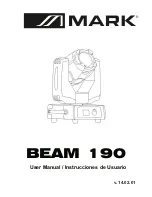
6
•
Never use the cord to carry, pull or unplug the power tool. Keep the cord away
from heat, oil, sharp edges, or moving parts.
•
Damaged or entangled cords increase the risk of electric shock.
•
Threading the power cord through a picking sleeve will prevent the cord tangling
or getting cut.
6) When using power tools outdoors, use an outdoor external cord. A cord suitable for
outdoor use will reduce the risk of electric shock.
7) If charging the tool in a damp location is unavoidable, use a residual current device
(RCD) protected supply. Use of an RCD reduces the risk of electric shock.
Bodily Safety
1) Be awake, alert and pay close attention during the operation of power tools. Do not
operate the power tool when you are tired, intoxicated or on medication. Falling asleep
or losing consciousness during in the operation of the power tool can result in serious
personal injury.
2) Use personal protective equipment. Always wear goggles and safety equipment such as
dust masks, non-slip safety shoes, hard hats, hearing protection, etc. Wearing safety
gear in appropriate conditions can reduce personal injury.
3) To prevent accidental start-up, make sure the switch is in the off position when
connecting the power supply, battery, picking up or carrying the tool. Inserting the plug
when the tool is plugged in or when it is turned on can be dangerous.
4) Remove all adjustment keys or wrenches before the power tool is turned on. A wrench
or key left on the moving parts of the power tool can cause personal injury.
5) Do not overextend your reach and lose balance. Always pay attention to your foothold
and body balance. This allows for good control of the power tool especially during
unexpected situations.
6) Dress properly. Do not wear loose clothing or jewelry. Keep clothing, gloves and hair
away from moving parts. Wearing loose clothes, accessories, or long hair may get
caught in moving parts.
7) If you are providing equipment for connection with chip evacuation and dust collection
equipment, make sure they are connected and used properly. Use these devices to
reduce the risk of dust.
Power Tool Use Safety
1) Don’t overload the tool by using it outside the designed operation specifications. Choose
the correct power tool for the job making your work more efficient and much safer.
2) Don’t attempt to use tool if any of the switches are not working properly. Power tools that
cannot be controlled with switches are dangerous and must be repaired.
3) Unplug your power tool from the power supply and/or the battery before any
adjustments, cleaning, maintenance, replacement of accessories or in preparation of
storage. This protective measure will reduce the risk of accidental start-up of the tool.
4) Store unused power tools outside the reach of children.







































